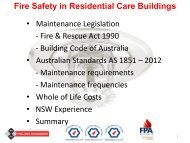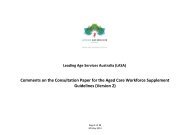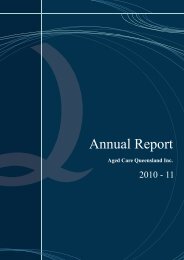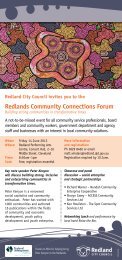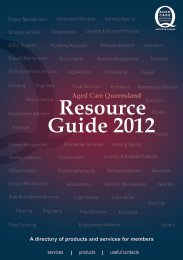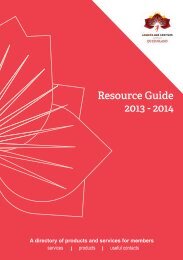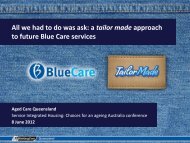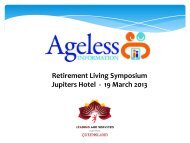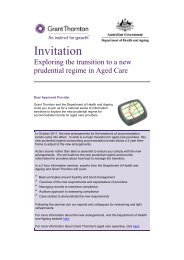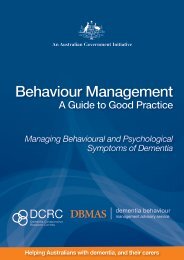LASA Q Focus Magazine - Leading Age Services Australia ...
LASA Q Focus Magazine - Leading Age Services Australia ...
LASA Q Focus Magazine - Leading Age Services Australia ...
You also want an ePaper? Increase the reach of your titles
YUMPU automatically turns print PDFs into web optimized ePapers that Google loves.
RESEARCHCurrent practices in assessmentand managementIn <strong>Australia</strong>, one of the aged carestatutory standards includes therequirement that all older peoplewho relocate into residentialaccommodation are providedwith a 72-hour UC assessment todevelop their UC care plan (<strong>Age</strong>dCare Accreditation Standards1997).Accurate assessment andindividualised care planningare the foundations of goodcontinence management,however they are ongoingand the consistent practice ischallenging. Most residentialfacilities rely on a manualurinary incontinence assessment.This typically involves care staffasking a resident about theirvoiding episodes or manuallychecking clothes or continencepad every 1 to 3 hours. Theinformation recorded is usedto establish a time and volumebladder chart to determine theresident’s level of incontinence.The failure to detect accuratevoiding patterns results in animpersonalised and undignifiedpractice where groups ofresidents are simultaneouslytaken to the toilet at the samepredetermined times each day.The way forward: InnovativeTechnologyInnovative technology is a wayforward to generate valid datato accurately assess the naturalbladder voiding pattern ofindividuals, to develop care plansto deliver individualised UC care.The UC care plans developedfrom digital assessments mightinclude a toileting assistanceprogram that optimises care staffworkflow and achieves effectivetoileting and appropriatecontinence aid selection forindividuals. A small range ofstudies have shown the benefitsof technology in providing moreeffective UC assessment andmanagement.Smart sensor technologyIn a study, Yu et al measuredthe voiding patterns of 32 olderpeople living with dementia ina RACF in Melbourne during a72-hour Urinary Incontinence(UI) assessment at two differenttime points using a sensortechnology called SIM ® (SmartIncontinence Management). Theinitial SIM ® assessment developeda bladder chart and recordedother observations based on thefacilities current continence careplan(Figure 1).The information from thisassessment was used to developa SIM ® continence care plan.This new continence care planwas implemented and a secondassessment (example figure 2)was conducted 2 to 5 weeks afterimplementation to measure theeffectiveness of the care plan.The results showed statisticallysignificant outcomes: reductionin the volume of urine voidedinto continence aids, increase insuccessful toileting events andan increased level of adherenceto the number of toilet visitsprescribed in the care plans(Figure 2)The study demonstrated thatan instrumented electronicincontinence assessment toolhas the potential to improvecontinence care outcomes andrelated health impacts.References1. O’Connell B, Ostaszkiewicz J, Hawkins M(2011) A suite of evidence-based continenceassessment tools for residential aged care.Australasian Journal on <strong>Age</strong>ing 30.2 Yu P, Hailey D, Fleming R, Zhang Z,Traynor V (2012) Evaluating the impactof implementing of a new wirelesstelemonitoring system for urinary continencemanagement for older people living innursing homes. International ContinenceSociety Conference, Beijing.Paul FishHead of Marketing and ClinicalResearch of Simavita1300 746 736pfish@simavita.comAdvertisein our next issueCommunityMembersResidentialRetirement LivingLegislationTechnologyFor advertising contactHugo Silva on07 3725 5555 orhugo.silva@qld.lasa.asn.au<strong>LASA</strong>-Q <strong>Focus</strong> | Autumn edition 2013 15



